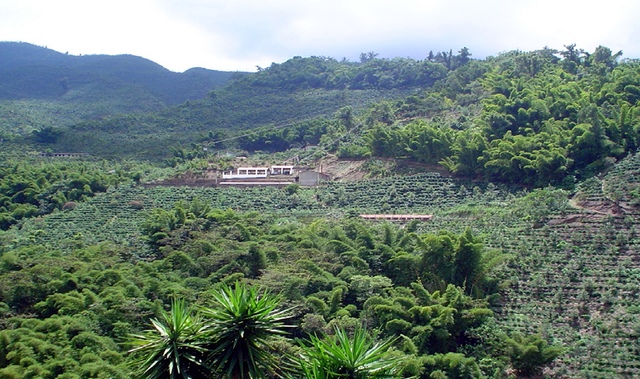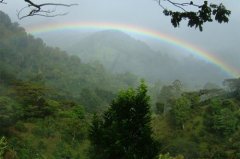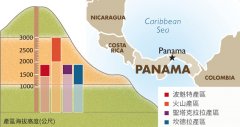Introduction to Kotowa Coffee of Millennium Rainforest in Panamanian Coffee region Boquete

Professional barista communication, please pay attention to coffee workshop (Weixin Official Accounts cafe_style)
Panamanian coffee-producing region Boquete Millennium Rainforest Kotowa Coffee Introduction
Panama is located in Central America, with Costa Rica on the left and Colombia on the right. Although it is a small country connecting North and South America, it has an important strategic position. Its Panama Canal, which runs through the North Atlantic Ocean and the South Pacific Ocean, once caused fierce competition between the United States and France. Today, Geisha coffee produced in Panama is a must-win bean for merchants, from US $92.3 per pound in 2011 to US $107.86 per pound in 2014. This year's public auction price hit a new high, with raw beans plunging to $140 a pound.
Panama's most famous coffee-producing areas, Boquete and Volcán, are located in the highlands of Chiriqui Province in the west, near the Costa Rican border. In search of the best coffee, I went to live in both regions for a week and visited several coffee plantations. Panama is one of the most advanced coffee producing areas I have been to, except for the United States. The price is also one of the higher ones. Many famous estates can be driven directly by RV. I took the night bus from Panama City, a seven-hour drive to David in daylight, and then took a taxi to Boquet.
Millennium Rainforest Kotowa Coffee
Kotowa Coffee family has 5 manors, each of which has great microclimate changes. Guixia Manor is located in the original tropical rain forest reserve with an altitude of more than 1,600 meters. Coffee trees and towering rainforest trees are complete. The climate is cool. Clear river water flows through the garden and shuttles through the coffee garden. The fog always transpires, just like a fairyland. The environment is very beautiful. Kotowa is one of the oldest coffee plantations in the area, a family farm founded by Canadians in 1918 and now run by third-generation grandson Ricardo Koyner. I was lucky enough to pick red rose cherries and visit his grandfather's century-old wood coffee peeling machine. Kotowa is also a birdwatcher's paradise…For safety and environmental sustainability, the farm does not use any chemical pesticides or herbicides, thus attracting some rare birds to live here.
Volcano Secret Janson Rose Summer Dried Fruit Tea
Driving around Volcán Baru and heading west for about 1.5 hours, I came to Janson Coffee Farm, which came in second place in the Best of Panama 2013 coffee contest. The contest was started in 1997 by the Panamanian Fine Coffee Association (SCAP), two years before the first COE! Swiss Carl Janson loved the beautiful environment of the mountains and nearby valleys, so he bought a large area of land to start a farm, raising cattle, fish and horses, and planting coffee in large quantities. Now the estate is handed over to his descendants.
Carl's grandson Leif Janson took me on a four-wheel drive to tour his coffee garden. I noticed that Volcán, on the other side of the volcano, had a distinctly different microclimate than Boquet, where there was more sunlight. The rich volcanic soil and microclimate here make the small variety of Rosedale coffee thrive. Coupled with the natural spring water washing and treatment of coffee, the fruit and flower flavor that tempts the taste buds is very special! Janson also uses a special method to remove the skin and pulp of coffee cherries and then dry them in the sun to become dried fruit tea. After soaking in hot water, the sweetness originally in the pulp is completely released, sour and sweet, with a unique rose flower fragrance, rose flower and cherry fruit fragrance, this pink fruit tea, make people fall in love with it!
Important Notice :
前街咖啡 FrontStreet Coffee has moved to new addredd:
FrontStreet Coffee Address: 315,Donghua East Road,GuangZhou
Tel:020 38364473
- Prev

Panamanian Coffee Manor Kotowa Family introduces special and exquisite Panamanian coffee
Professional baristas please follow the coffee workshop (Wechat official account cafe_style) for a long time underestimated or even ignored Panamanian coffee, until the annual international cup test competition held in recent years, the emergence of the best coffee in Panama Best of Panama and Panama Emerald Manor (Hacienda La Esmeralda) has completely changed, this cup test competition has been widely held all over the world.
- Next

Introduction to the four Coffee producing areas in Panama and the Road to Fine Coffee the most Rose Summer in the World-Panama
Communication of professional baristas Please follow the History of Coffee in Panama in the Coffee Workshop (official Wechat account cafe_style) in 1780, the history of Panamanian coffee began when Europeans first introduced the first Typica tree species to Panama. For Panamanians at that time, such drinks were both novel and mysterious, and not only conquered people quickly.
Related
- Detailed explanation of Jadeite planting Land in Panamanian Jadeite Manor introduction to the grading system of Jadeite competitive bidding, Red bid, Green bid and Rose Summer
- Story of Coffee planting in Brenka region of Costa Rica Stonehenge Manor anaerobic heavy honey treatment of flavor mouth
- What's on the barrel of Blue Mountain Coffee beans?
- Can American coffee also pull flowers? How to use hot American style to pull out a good-looking pattern?
- Can you make a cold extract with coffee beans? What is the right proportion for cold-extracted coffee formula?
- Indonesian PWN Gold Mandrine Coffee Origin Features Flavor How to Chong? Mandolin coffee is American.
- A brief introduction to the flavor characteristics of Brazilian yellow bourbon coffee beans
- What is the effect of different water quality on the flavor of cold-extracted coffee? What kind of water is best for brewing coffee?
- Why do you think of Rose Summer whenever you mention Panamanian coffee?
- Introduction to the characteristics of authentic blue mountain coffee bean producing areas? What is the CIB Coffee Authority in Jamaica?

